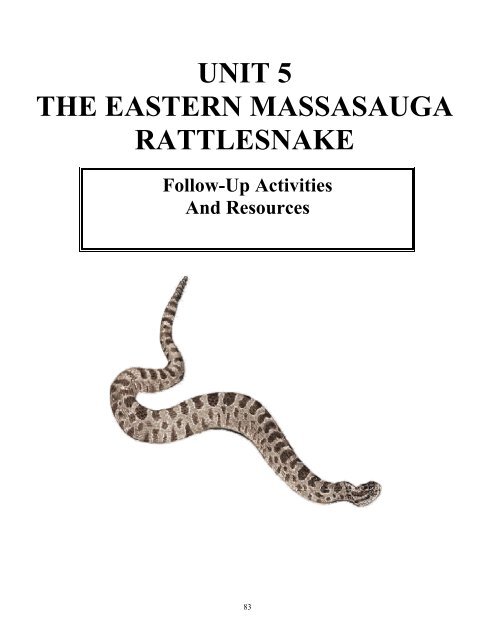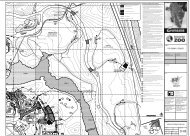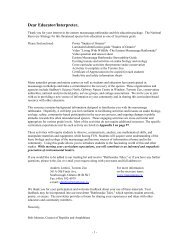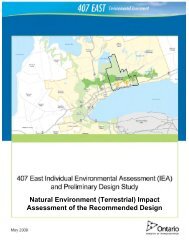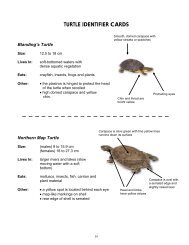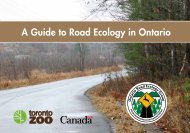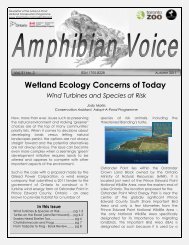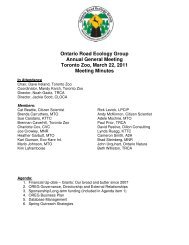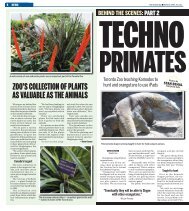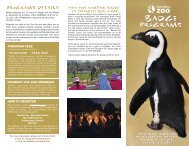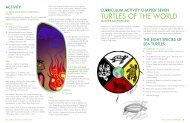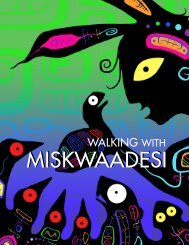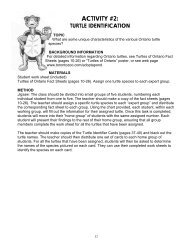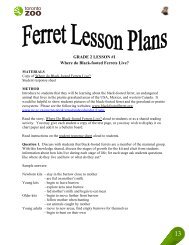UNIT 5 THE EASTERN MASSASAUGA RATTLESNAKE - Toronto Zoo
UNIT 5 THE EASTERN MASSASAUGA RATTLESNAKE - Toronto Zoo
UNIT 5 THE EASTERN MASSASAUGA RATTLESNAKE - Toronto Zoo
You also want an ePaper? Increase the reach of your titles
YUMPU automatically turns print PDFs into web optimized ePapers that Google loves.
<strong>UNIT</strong> 5<br />
<strong>THE</strong> <strong>EASTERN</strong> <strong>MASSASAUGA</strong><br />
<strong>RATTLESNAKE</strong><br />
Follow-Up Activities<br />
And Resources<br />
83
Rattlesnake Curriculum Resource<br />
Unit 5: The Eastern Massasauga Rattlesnake<br />
Teacher Resource<br />
GROUP WORK<br />
AND<br />
RESEARCH MOTIVATORS<br />
What can we do to preserve the Eastern Massasauga Rattlesnake and its natural habitat?<br />
Why is it important to save the Eastern Massasauga Rattlesnake? What would be the<br />
consequences of its extinction?<br />
Explore other vipers and compare them with the Eastern Massasauga Rattlesnake.<br />
Are rattlesnakes efficient predators? Explore the different methods snakes use to capture and kill<br />
their prey.<br />
What organizations can help you find information on rattlesnakes and explain how you can share<br />
their habitat?<br />
What is anti-venom? How is it made? Discuss the risks and benefits of using anti-venom.<br />
Explore the strategies different snakes use to ward off predators and protect themselves.<br />
How has the Eastern Massasauga Rattlesnake range changed in Ontario in the last decade?<br />
85
Rattlesnake Curriculum Resource<br />
Unit 5: The Eastern Massasauga Rattlesnake<br />
Student Activity Sheet<br />
Name:_______________________<br />
Date:________________________<br />
AT <strong>THE</strong> ZOO…<br />
<strong>RATTLESNAKE</strong> OBSERVATION ACTIVITY<br />
Features and Distinguishing Traits<br />
1. Describe the colour and markings of the Eastern Massasauga Rattlesnake. Compare<br />
the colour and markings to at least one other snake species found at the zoo.<br />
________________________________________________________________________<br />
________________________________________________________________________<br />
________________________________________________________________________<br />
________________________________________________________________________<br />
________________________________________________________________________<br />
2. What are two distinguishing features of the Eastern Massasauga Rattlesnake?<br />
________________________________________________________________________<br />
________________________________________________________________________<br />
________________________________________________________________________<br />
________________________________________________________________________<br />
________________________________________________________________________<br />
________________________________________________________________________<br />
3. What makes the Eastern Massasauga Rattlesnake different from other Ontario<br />
snakes?<br />
________________________________________________________________________<br />
________________________________________________________________________<br />
________________________________________________________________________<br />
________________________________________________________________________<br />
________________________________________________________________________<br />
4. What is the rattle of the Eastern Massasauga Rattlesnake used for? How does the<br />
snake use its rattle?<br />
________________________________________________________________________<br />
________________________________________________________________________<br />
________________________________________________________________________<br />
________________________________________________________________________<br />
________________________________________________________________________<br />
5. What are the heat-sensitive pits (found on either side of the face between the eye and<br />
the nostril) used for?<br />
________________________________________________________________________<br />
________________________________________________________________________<br />
________________________________________________________________________<br />
________________________________________________________________________<br />
________________________________________________________________________<br />
________________________________________________________________________<br />
86
Habitat<br />
1. Observe the Eastern Massasauga Rattlesnake in its natural environment (in the zoo<br />
display). Draw a pencil-sketch of the snake and its positioning within this<br />
environment.<br />
87
Rattlesnake Curriculum Resource<br />
Unit 5: The Eastern Massasauga Rattlesnake<br />
Student Activity Sheet<br />
Name:_______________________<br />
Date:________________________<br />
2. Explain why the snake is resting where it is. (Is it near shelter? Will its body be<br />
warm or cold in this spot?)<br />
________________________________________________________________________<br />
________________________________________________________________________<br />
________________________________________________________________________<br />
________________________________________________________________________<br />
________________________________________________________________________<br />
________________________________________________________________________<br />
3. What was the original Ontario range in which the Eastern Massasauga Rattlesnake<br />
lived? What is its current Ontario range?<br />
________________________________________________________________________<br />
________________________________________________________________________<br />
________________________________________________________________________<br />
________________________________________________________________________<br />
________________________________________________________________________<br />
4. List a few reasons for the decrease in population of the Eastern Massasauga<br />
Rattlesnake.<br />
________________________________________________________________________<br />
________________________________________________________________________<br />
________________________________________________________________________<br />
________________________________________________________________________<br />
________________________________________________________________________<br />
________________________________________________________________________<br />
5. What other snakes can be found in Ontario?<br />
________________________________________________________________________<br />
________________________________________________________________________<br />
________________________________________________________________________<br />
________________________________________________________________________<br />
________________________________________________________________________<br />
Snake Encounters<br />
1. What should you do if you hear a snake rattle while you are walking in the forest?<br />
(Push the button on the display.)<br />
________________________________________________________________________<br />
________________________________________________________________________<br />
________________________________________________________________________<br />
________________________________________________________________________<br />
________________________________________________________________________<br />
2. Give one suggestion on how you can help the Eastern Massasauga Rattlesnake.<br />
________________________________________________________________________<br />
________________________________________________________________________<br />
88
Rattlesnake Curriculum Resource<br />
Unit 5: The Eastern Massasauga Rattlesnake<br />
Teacher Resource- Answer Sheet<br />
AT <strong>THE</strong> ZOO…<br />
<strong>RATTLESNAKE</strong> OBSERVATION ACTIVITY-<br />
ANSWER SHEET<br />
Features and Distinguishing Traits<br />
1. Describe the colour and markings of the Eastern Massasauga Rattlesnake. Compare<br />
the colour and markings to at least one other snake species found at the zoo.<br />
Answers will vary<br />
Should include: skin is grey with a row of rounded brown-black blotches down the<br />
centre of the back and three smaller rows of alternating blotches down each side.<br />
2. What are two distinguishing features of the Eastern Massasauga Rattlesnake?<br />
a. The warning rattle on the tip of the tail.<br />
b. The heat-sensitive pits on each side of the head between the nostrils and the eyes.<br />
3. What makes the Eastern Massasauga Rattlesnake different from other Ontario snakes?<br />
Has a vertical eye pupil. Is venomous.<br />
4. What is the rattle of the Eastern Massasauga Rattlesnake used for? How does the snake use<br />
its rattle?<br />
The rattle is used as a warning device. The snake lifts its tail slightly and vibrates the<br />
hollow segments of the rattle.<br />
5. What are the heat-sensitive pits (found on either side of the face between the eye and the<br />
nostril) used for?<br />
They are used to find warm-blooded prey. A rattlesnake can find the exact location of a<br />
warm-blooded prey within 60 cm, even in complete darkness!<br />
Habitat<br />
1. Observe the Eastern Massasauga Rattlesnake in the zoo display. Draw a pencil-sketch of the<br />
snake and its positioning within this environment.<br />
Drawings by students will vary, as will the position of the snake on particular day of trip.<br />
The zoo places under-floor warm areas for the snakes to use (thermoregulate).<br />
89
Rattlesnake Curriculum Resource<br />
Unit 5: The Eastern Massasauga Rattlesnake<br />
Teacher Resource- Answer Sheet<br />
2. Explain why the snake is resting where it is. (Is it near shelter? Will its body be<br />
warm or cold in this spot?)<br />
Answers will vary.<br />
For example, on a warm day snakes can be found basking in the sun in order to<br />
regulate its body temperature. (Cold-blooded organisms require environmental<br />
contributions to regulate their body temperature.)<br />
3. What was the original Ontario range in which the Eastern Massasauga Rattlesnake lived?<br />
What is its current Ontario range?<br />
Original Range: much wider range included parts of Southern Ontario<br />
Present Range: Ojibway Prarie Complex, Wainfleet Bog, part of the Bruce Peninsula,<br />
areas along the Eastern shores and adjacent islands of Georgian Bay.<br />
4. List a few reasons for the decrease in population of the Eastern Massasauga Rattlesnake.<br />
Answers will vary.<br />
Destruction of natural habitat (occurs largely due to development activities; the<br />
Eastern Massasauga has highly specific habitat needs and cannot be easily relocated),<br />
habitat fragmentation (due to construction activities), human persecution (due to fear<br />
and hunting of species), collection of snakes for illegal pet trade.<br />
5. What other snakes can be found in Ontario?<br />
Answers will vary<br />
Examples include: Eastern Milk Snake, Northern Water Snake, Lake Erie Water<br />
Snake, Eastern Fox Snake, Northern Brown Snake, Northern Ribbon Snake, Eastern<br />
Garter Snake, Red-sided Garter Snake, Butler’s Garter Snake, Northern Redbelly<br />
Snake, Smooth Green Snake, Northern Ringneck Snake, Queen’s Snake, Blue Racer,<br />
Black Rat Snake.<br />
Snake Encounters<br />
1. What should you do if you hear a snake rattle while you are walking in the forest? (Push the<br />
button on the display.)<br />
Leave the snake alone and it will depart on its own. Walk quickly away and allow the<br />
snake to escape.<br />
2. Give one suggestion on how you can help the Eastern Massasauga Rattlesnake.<br />
Answers will vary.<br />
Create and/or maintain natural habitats, report your snake sightings (Phone # 705-755-<br />
2159; Website: www.mnr.gov.on.ca/MNR/nhic/nhic.html), be a concerned camper,<br />
cottager or property owner.<br />
90
Rattlesnake Curriculum Resource<br />
Unit 5: The Eastern Massasauga Rattlesnake<br />
Teacher Resource<br />
ACTIVITIES FOR <strong>THE</strong> TORONTO ZOO, OJIBWAY NATURE<br />
CENTRE, AND SCIENCE NORTH !<br />
BEFORE YOU COME...<br />
EXHIBIT DESIGN<br />
Exhibits in zoos are designed to represent part of the natural world. <strong>Zoo</strong>s are placing an<br />
increasing emphasis on ecological issues and conservation programs. Ideally, exhibits are<br />
interpretative, natural, stimulating, and strategically placed to illustrate the interrelationship of<br />
animals and plants in the wild.<br />
Exhibit Design Choices:<br />
Geographical: Organized by continent or land forms (zoogeographic)<br />
Ecological: Reflecting an animal's habitat (i.e. cloud forest, desert, pond, etc.)<br />
Systematic: A traditional exhibition style where animals are separated (i.e. bear house,<br />
monkey house, reptile house, etc.)<br />
Theme: An exhibit with an obvious message, such as a nocturnal house or a children's<br />
zoo.<br />
Behavioural: Demonstrating an adaptation such as social behaviour in a group of animals.<br />
Mixed species: An exhibit that shows the relationships between animals occupying<br />
different niches within one habitat.<br />
Museum: Preserved specimens. This could include whole animals, or interpretative<br />
displays of objects such as eggs, antlers, or skins.<br />
Exhibits at the <strong>Toronto</strong> <strong>Zoo</strong> are organized using <strong>Zoo</strong>geographical separation. Our land form<br />
groups include: the Americas, Australasia, Africa (savannah and rain forest),Eurasia, Indomalaya,<br />
and the Canadian Domain.<br />
AN EXHIBIT ALL YOUR OWN . . .<br />
Design an educational exhibit for the massasauga rattlesnake. Use a cardboard box as your<br />
exhibit space- you can design a “bird’s-eye-view” exhibit or cut out the front of the box to form a<br />
front view to the exhibit. Refer to information from this education package and from the library<br />
before beginning construction. Use natural materials or colored modeling clay. The following<br />
are questions you should answer and apply to your exhibit design:<br />
• Do snakes climb?<br />
• Do they need water?<br />
• What type of habitat(s) is/are required?<br />
• How will the keepers clean the exhibit safely?<br />
• How will the snake get heat?<br />
• What tools need to be provided for safe cleaning or holding?<br />
• Will my design be interesting and allow visitors to observe the snake while causing the least, if<br />
no, disturbance to the animal?<br />
• Is my exhibit design comprehensible to most age groups?<br />
Ensure that interpretative elements, such as graphics, and relevant information is included as part<br />
of the exhibit. Design a poster to go with your exhibit. (Relate this exercise to Activity #5 in the<br />
Conservation Section)<br />
91
Rattlesnake Curriculum Resource<br />
Unit 5: The Eastern Massasauga Rattlesnake<br />
Teacher Resource<br />
ONCE YOU ARRIVE...<br />
Come to the <strong>Toronto</strong> <strong>Zoo</strong> and compare your exhibit to the massasauga rattlesnake exhibit in the<br />
America's pavilion. Get up close to a rescued rattlesnake at Ojibway Nature Centre, Science<br />
North, and several of Ontario's national and provincial parks interpretative programmes.<br />
92
Rattlesnake Curriculum Resource<br />
Unit 5: The Eastern Massasauga Rattlesnake<br />
Teacher Resource<br />
<strong>RATTLESNAKE</strong> RESOURCES<br />
This section includes references and information sources for educators and students, as well as<br />
listing organizations that have particular interests in rattlesnakes, and/or conservation in general.<br />
Web Page and Links<br />
Eastern Massasauga Rattlesnake Recovery Team<br />
www.massasauga.ca<br />
Organizations You May Wish To Contact<br />
<strong>Toronto</strong> <strong>Zoo</strong><br />
Curator of Amphibians and Reptiles<br />
(416) 392-5968<br />
361-A Old Finch Ave.<br />
Scarborough, ON, M1B 5K7<br />
www.torontozoo.com<br />
Ojibway Nature Centre<br />
5200 Matchette Road<br />
Windsor, ON, N9C 4E8<br />
(519) 966-5852<br />
www.ojibway.ca<br />
Science North<br />
100 Ramsey Lake Road<br />
Sudbury, ON, P3E 5S9<br />
(705) 522-3701<br />
www.sciencenorth.on.ca<br />
Georgian Bay Islands National Park<br />
P.O. Box 28<br />
Honey Harbour, ON, P0E 1E0<br />
(705) 526-9804<br />
http://www.pc.gc.ca/pn-np/on/georg/edu/index_e.asp<br />
Bruce Peninsula National Park<br />
P.O. Box 189<br />
Tobermory, ON, N0H 2R0<br />
(519) 596-2444<br />
www.pc.gc.ca/pn-np/bruce/index_3.asp<br />
Grundy Lake Provincial Park<br />
R.R. 1,<br />
Britt, ON, P0G 1A0<br />
(705) 383-2286<br />
www.ontarioparks.com/english/grun.html<br />
93
Rattlesnake Curriculum Resource<br />
Unit 5: The Eastern Massasauga Rattlesnake<br />
Teacher Resource<br />
Killbear Provincial Park<br />
P.O. Box 71<br />
Nobel, ON<br />
P0G 1G0<br />
(705) 342-5492<br />
www.ontarioparks.com/english/killb.html<br />
Massasauga Provincial Park<br />
RR#2 Parry Sound<br />
ON, P2A 2W8<br />
(705) 378-2401<br />
Ministry of Natural Resources (Parry Sound)<br />
7 Bay Street<br />
Parry Sound, ON, P2A 1S4<br />
(705) 746-4201<br />
Ministry of Natural Resources (Owen Sound)<br />
1450 7Th Avenue East<br />
Owen Sound, ON, N4K 3E4<br />
(519) 376-3860<br />
Ministry of Natural Resources (Niagara)<br />
P.O. Box 5000<br />
4890 Victoria Avenue North<br />
Vineland Station, ON, L0R 2E0<br />
(905)562-4147<br />
Niagara Peninsula Conservation Authority<br />
250 Thorold Rd. W. 3rd Floor<br />
Welland, ON, L3C 3W2<br />
(905) 788-3135<br />
www.conservation_niagara.on.ca<br />
Committee on the Status of Endangered Wildlife in Canada<br />
(COSEWIC)<br />
c/o Canadian Wildlife Service<br />
Environment Canada<br />
Ottawa, ON, K1A 0H3<br />
www.cosewic.gc.ca<br />
Federation of Ontario Naturalists<br />
355 Lesmill Rd.<br />
Don Mills, ON, M3B 2W8<br />
(416) 444-8419 or 1-800-440-2366<br />
www.ontarionature.org<br />
94
Rattlesnake Curriculum Resource<br />
Unit 5: The Eastern Massasauga Rattlesnake<br />
Teacher Resource<br />
O<strong>THE</strong>R REFERENCES<br />
Behler, J.L. and F.W. King. 1979. The Audubon's Society Field Guide to North American<br />
Reptiles. Alfred A. Knopf Publishers: New York, 1979. 717 pp.<br />
Conant, R. and J.T. Collins. A Field Guide to Reptiles and Amphibians of Eastern and Central<br />
North America. Peterson Field Guide Services, Houghton-Mifflin: Boston, 1991. 429 pp.<br />
Cooke, F.R. Introduction to Canadian Amphibians and Reptiles. Canadian Museum of Nature:<br />
Ottawa, 1984. 200 pp.<br />
Johnson, B. Familiar Amphibians and Reptiles of Ontario. Natural History Press: <strong>Toronto</strong>, 1989.<br />
189 pp.<br />
Rubio, Manny. Rattlesnake: Portrait of a Predator. Smithsonian Institution Press: Washington,<br />
1998. 240 pp.<br />
Tennant, A. and R.D. Bartlett. Snakes of North America, Eastern and Central Regions. Gulf<br />
Publishing Company: Houston, 2000. 588 pp.<br />
Thomas F. Tyning. A Guide to Amphibians and Reptiles, first edition. Stokes Nature Guide<br />
Series: USA, 1990. 400 pp.<br />
Snakes of Ontario Identifier (Available from <strong>Zoo</strong> Gift Shop or Curator of Amphibians and<br />
Reptiles, <strong>Toronto</strong> <strong>Zoo</strong> 361-A Old Finch Ave. Scarborough, Ontario M1B 5K7 Cost: $3.00)<br />
Snakes of Ontario Poster (Available from Recovery Team Members or Curator of Amphibians<br />
and Reptiles, <strong>Toronto</strong> <strong>Zoo</strong> 361-A Old Finch Ave. Scarborough, Ontario M1B 5K7)<br />
95


